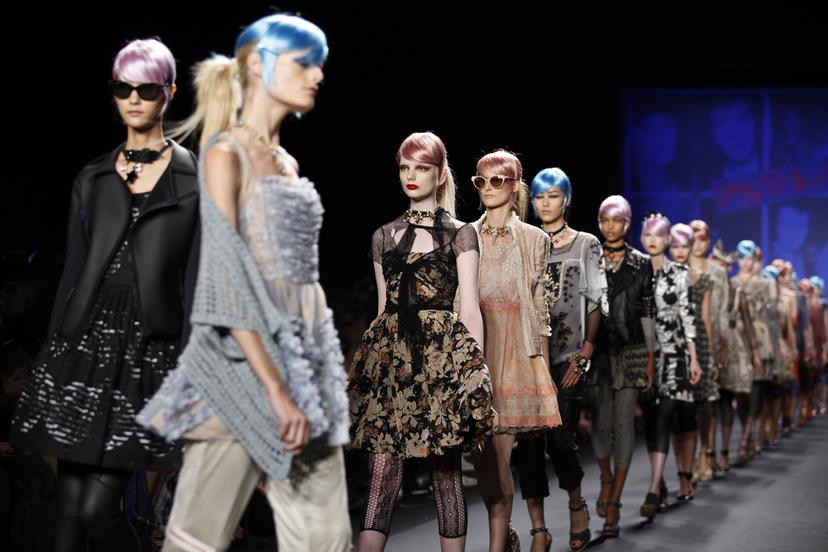Fashion and Apparel

Industry Outlook
In the face of foreign competition, the future of the apparel industry is unclear. Employment in the domestic apparel industry has declined dramatically in recent years as foreign companies have become able to produce goods less expensively than the United States. Changing trade regulations are the most significant factor in this decline. In 2005, the World Trade Organization lifted quotas for apparel and textile products that have prompted U.S. retailers to import greater quantities of apparel that is made in foreign countries with less expensive labor. In addition, domestic production has continued to move abroad, causing further employment decline for apparel workers in the United States.
According to a 2018 report from Dr. Sheng Lu, associate professor in the University of Delaware's Department of Fashion & Apparel Studies, the Department of Labor (DOL) revealed that 44.2 percent and 56.3 percent of jobs in the U.S. textile and apparel sectors, respectively, were lost between January 2005 and December 2017. In 2017 alone, losses included 4,100 textile jobs and 10,100 apparel jobs.
Declining employment will be caused by growing imports and competition from foreign markets, new technology, and cost-cutting practices imposed by retailers. Many U.S. firms will continue to move their assembly operations to low-wage countries, which will adversely affect employment for lower-skilled machine operators. However, much of the apparel will still be designed and cut in the United States, which will maintain the demand for some pre-sewing functions.
The DOL reports that fashion designers who work in apparel manufacturing will experience a 31 percent decline in employment between 2018 and 2028. On the other hand, 25 percent employment growth is predicted for fashion designers in the retail trade during this timeframe. The DOL attributes this growth to the increased demand for more fashion-inspired clothing and accessories for everyday wear and the mass market.
Technological changes continue to affect the fashion manufacturing process. Many apparel manufacturers now use computer systems to design products, make patterns, and present their products to buyers. Many of the operations at apparel factories are difficult to automate, however, because of the large variety of fabrics and the intricate cutting and sewing required of most fashions, so the fashion industry is likely to remain labor-intensive. However, pressers, textile, garment, and related materials; textile bleaching and dyeing machine operators and tenders; and textile knitting and weaving machine setters, operators, and tenders are among the occupations that will experience the fastest employment declines between 2018 and 2028, according the the DOL. Workers who have knowledge of computer-aided design and computer-aided manufacturing will have the best employment prospects.
Early in the coronavirus pandemic that began in 2020, large retail outlets and manufacturers, such as H&M and Nike, experienced serious setbacks as restrictions on public activity forced them to close the doors of their brick-and-mortar shops. In addition, interruptions in supply chains made it more difficult to obtain raw materials for apparel production, and restrictions on trade and travel diminished access to overseas manufacturers. Traditional, in-person fashion shows, conferences, and other events moved to virtual platforms, or, in some cases, canceled or postponed. Some jobs in this industry were lost, especially at the retail and manufacturing level, while business closed to help slow the spread of coronavirus.
The global apparel market is expected to have strong growth in 2021 as the pandemic becomes contained and the economy rebounds. A forecast by Research and Markets estimates compound annual growth of nearly 21 percent in 2021, growing from $527.08 billion in 2020 to $635.17 in 2021. According to the forecast, this growth will be attributed to apparel companies "rearranging their operations and recovering from the COVID-19 impact, which had earlier led to restrictive containment measures involving social distancing, remote working, and the closure of commercial activities that resulted in operational challenges." The global apparel market is project to reach $842.73 billion in 2025, growing at a 7 percent compound annual growth rate.
A McKinsey report on the fashion industry foresees several key trends that the industry will focus on in post-pandemic times. In 2020, many fashion companies were able to streamline their businesses and hone their business models and customer propositions; this focus on improving business efficiency is expected to continue. Fashion sales are expected to pick up by 2023 in the U.S., due primarily to digital channels, which have been another trend that evolved during the pandemic. In fact, the McKinsey report predicts more than 20 percent digital growth in 2021 (and 30 percent growth in the U.S. and Europe) compared to 2020. Another trend that will carry forward from the pandemic is that consumers' awareness of justice for vulnerable fashion workers has been heightened, therefore fashion companies will need to focus on offering justice and dignity to their employees. Sustainability in the fashion design and apparel industry will also grow in importance in the coming years.
